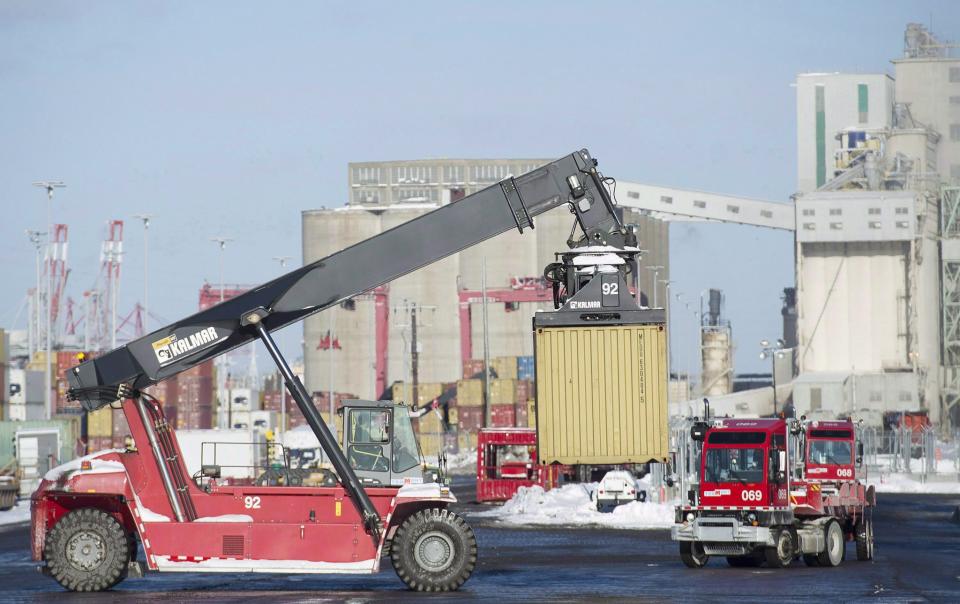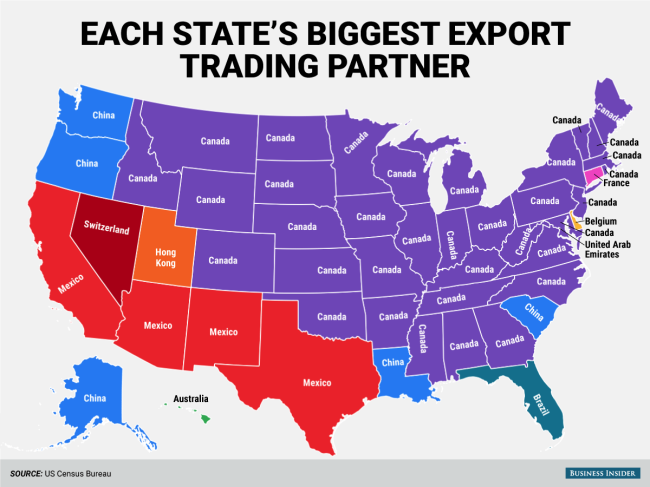Many U.S. states have lots to lose if Canada is no longer a trading partner

Prime Minister Justin Trudeau’s inner circle is meeting this week to discuss trade strategy and dispel worries surrounding the relations between important trading partners Canada and the U.S. going forward under the Trump Administration.
President Donald Trump began his first full week in office by signing an executive order to withdraw from the Trans-Pacific Partnership (TPP) – a trade deal which covered 40 per cent of the world’s economy reducing tariffs and geared towards boosting economic growth – and has also signalled plans to renegotiate NAFTA.
But changing the trade relationship between Canada and the U.S. could prove a gargantuan task.
To put it in perspective, according to the Federal government, under NAFTA trade in goods and services between Canada and the U.S. reached close to $881 billion in 2015 with Canada being the second largest market for U.S. services exports. The U.S. is the number one destination for Canadian merchandise exports and Canada’s largest supplier of merchandise imports. Canada is the main foreign supplier of energy to the U.S. and the “largest cumulative source of foreign direct investment (FDI) into the United States.”
As part of the retreat, Stephen Schwarzman, head of President Trump’s strategic and policy forum – which includes CEOs from General Motors, IBM, Walt Disney and Walmart – met both privately with the Prime Minister and then with ministers hoping to quell worries.
“I think trade between the U.S. and Canada is really very much in balance and is a model for the way that trade relations should be… So I think Canada is very well positioned for any discussions with the United States,” said Schwartzman at the meeting, according to a report by The Globe and Mail.
Both countries are enmeshed, but on a state-by-state basis some would be hurt worse than others should President Trump “rip up” NAFTA as promised. In the latest statistics from the U.S. Census Bureau, our neighbours to the south imported over US$24.5 billion from Canada in November 2016, only US$200 million shy of Mexico at US$24.7 billion. It’s worth noting the U.S. imported $38.8 billion from China in that same month. Canada was the number one export partner in November with the U.S. sending US$21.2 billion worth of goods there.
Broken down by state data, in 2015 Canada was the number one export partner for 35 U.S. states. Indiana, Iowa, Missouri, Montana, Oklahoma, Pennsylvania, Vermont, West Virginia and Wisconsin send a third (or close to a third) of their total exports into Canada.

Canada accounts for just shy of 40 per cent of Ohio’s exports totalling US$20.3 billion. Michigan sends 43.6 per cent of its exports to Canada accounting for US$23.5 billion in 2015. Maine sends around 47 per cent of its exports north, US$1.2 billion in 2015. Canada receives 71.5 per cent of North Dakota’s exports, around US$2.7 billion. While Canada is California’s second biggest export market, the state still sent US$17 billion to Canada last year.
On the import side, 15 states call Canada their number one trading partner. Michigan imported a whopping US$45.7 billion in goods and services from Canada, nearly 37 per cent of the state’s overall imports. Illinois imported US$29.5 billion worth of goods and services in 2015 while California imported US$27 billion from Canada. Meanwhile, New York imported US$18 billion from Canada. Other states, including Vermont and Wyoming, get nearly 75 per cent of their imports from Canada.
As Trump looks to renegotiate the free trade agreement with Canada, there’s no doubt some states, many of which that voted him in (including Michigan) have a lot at stake. But as Dawn Desjardins, deputy chief economist at RBC Economic Research, told Maclean’s last week, the biggest hurdle for free trade is more likely to come from import taxes, presenting “one of the greatest risks to Canada’s economy in the near term.”
While three-quarters of Canada’s exports go stateside, many are used in the production of U.S. goods.
“The levying of a tariff that results in sharply higher costs of Canadian exports would translate into a significant boost to prices for finished goods and potentially result in the dissolution of these trading relationships,” Desjardins told the magazine. “Either result risks crippling production in many important industries on both sides of the border, leading to slower economic growth not only in Canada but in the U.S. as well.”

 Yahoo Finance
Yahoo Finance 